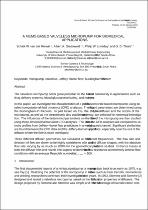JavaScript is disabled for your browser. Some features of this site may not work without it.
- ResearchSpace
- →
- Research Publications/Outputs
- →
- Conference Publications
- →
- View Item
| dc.contributor.author |
Van der Merwe, SW

|
|
| dc.contributor.author |
Groenwold, AA

|
|
| dc.contributor.author |
Loveday, Philip W

|
|
| dc.contributor.author |
Thiart, GD

|
|
| dc.date.accessioned | 2011-11-30T07:33:25Z | |
| dc.date.available | 2011-11-30T07:33:25Z | |
| dc.date.issued | 2010-01 | |
| dc.identifier.citation | Van der Merwe, SW, Groenwold, AA, Loveday, PW and Thiart, GD. 2010. A Mems based valveless micropump for biomedical applications. Seventh South African Conference on Computational and Applied Mechanics (SACAM10), Pretoria, 10-13 January 2010 | en_US |
| dc.identifier.uri | http://hdl.handle.net/10204/5346 | |
| dc.description | Seventh South African Conference on Computational and Applied Mechanics (SACAM10), Pretoria, 10-13 January 2010 | en_US |
| dc.description.abstract | The valveless micropump holds great potential for the biomedical community in applications such as drug delivery systems, blood glucose monitoring, and many others. In this paper, the authors investigate the characteristics of a planar diffuser/nozzle based micropump using detailed computational fluid dynamics (CFD) analyses. The significant parameters are determined using the Buckingham-Pi theorem. In part based on this, the shape of the diffuser and the nozzle of the micropump, as well as the piezoelectric disc oscillation frequency, are selected for numerical investigation. The influences of the determined parameters on the flow rate of the micropump are then studied using three dimensional transient CFD analyses. The data from the CFD analyses are compared to velocity profiles from Jeffery-Hamel flow predictions in a wedge shaped channel. Significant similarities are found between the CFD data and the Jeffery-Hamel velocity profiles, especially near the exit of the diffuser where the flow is more developed. Three different diffuser geometries are simulated at three different frequencies. The flow rate and direction of flow are shown to be highly sensitive to inlet and outlet diffuser shapes, with the absolute flow rate varying by as much as 200% for the geometrical perturbations studied. Entrance losses at both the diffuser inlet and nozzle inlet appear to dominate the flow resistance at extremely laminar flow conditions with an average Reynolds number of Reaverage ˜ 500. | en_US |
| dc.language.iso | en | en_US |
| dc.publisher | SACAM 2010 | en_US |
| dc.relation.ispartofseries | Workflow request;7640 | |
| dc.subject | Micropump | en_US |
| dc.subject | Valveless | en_US |
| dc.subject | Jeffery-Hamel flow | en_US |
| dc.subject | Buckingham-Pi theorem | en_US |
| dc.subject | Applied mechanics | en_US |
| dc.subject | SACAM 2010 | en_US |
| dc.title | A Mems based valveless micropump for biomedical applications | en_US |
| dc.type | Conference Presentation | en_US |
| dc.identifier.apacitation | Van der Merwe, S., Groenwold, A., Loveday, P. W., & Thiart, G. (2010). A Mems based valveless micropump for biomedical applications. SACAM 2010. http://hdl.handle.net/10204/5346 | en_ZA |
| dc.identifier.chicagocitation | Van der Merwe, SW, AA Groenwold, Philip W Loveday, and GD Thiart. "A Mems based valveless micropump for biomedical applications." (2010): http://hdl.handle.net/10204/5346 | en_ZA |
| dc.identifier.vancouvercitation | Van der Merwe S, Groenwold A, Loveday PW, Thiart G, A Mems based valveless micropump for biomedical applications; SACAM 2010; 2010. http://hdl.handle.net/10204/5346 . | en_ZA |
| dc.identifier.ris | TY - Conference Presentation AU - Van der Merwe, SW AU - Groenwold, AA AU - Loveday, Philip W AU - Thiart, GD AB - The valveless micropump holds great potential for the biomedical community in applications such as drug delivery systems, blood glucose monitoring, and many others. In this paper, the authors investigate the characteristics of a planar diffuser/nozzle based micropump using detailed computational fluid dynamics (CFD) analyses. The significant parameters are determined using the Buckingham-Pi theorem. In part based on this, the shape of the diffuser and the nozzle of the micropump, as well as the piezoelectric disc oscillation frequency, are selected for numerical investigation. The influences of the determined parameters on the flow rate of the micropump are then studied using three dimensional transient CFD analyses. The data from the CFD analyses are compared to velocity profiles from Jeffery-Hamel flow predictions in a wedge shaped channel. Significant similarities are found between the CFD data and the Jeffery-Hamel velocity profiles, especially near the exit of the diffuser where the flow is more developed. Three different diffuser geometries are simulated at three different frequencies. The flow rate and direction of flow are shown to be highly sensitive to inlet and outlet diffuser shapes, with the absolute flow rate varying by as much as 200% for the geometrical perturbations studied. Entrance losses at both the diffuser inlet and nozzle inlet appear to dominate the flow resistance at extremely laminar flow conditions with an average Reynolds number of Reaverage ˜ 500. DA - 2010-01 DB - ResearchSpace DP - CSIR KW - Micropump KW - Valveless KW - Jeffery-Hamel flow KW - Buckingham-Pi theorem KW - Applied mechanics KW - SACAM 2010 LK - https://researchspace.csir.co.za PY - 2010 T1 - A Mems based valveless micropump for biomedical applications TI - A Mems based valveless micropump for biomedical applications UR - http://hdl.handle.net/10204/5346 ER - | en_ZA |






